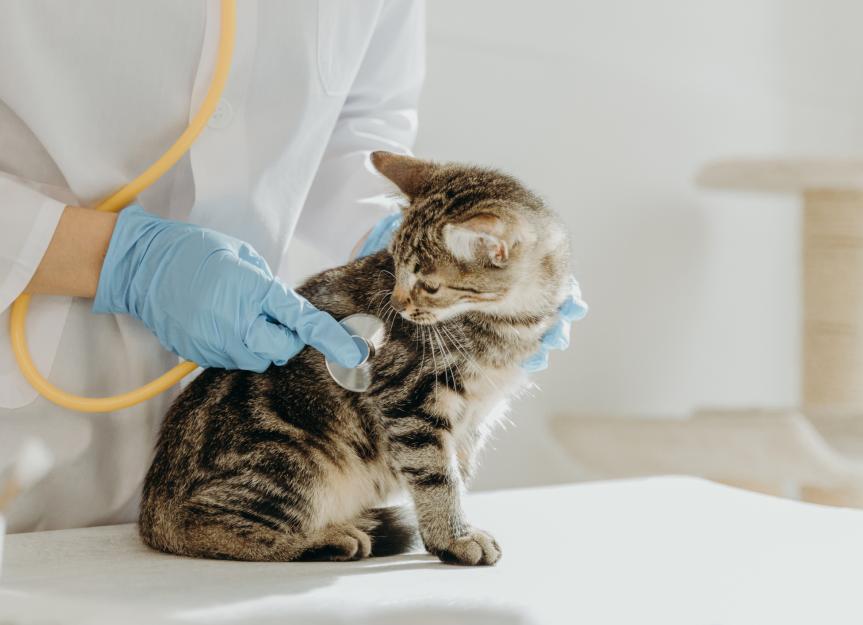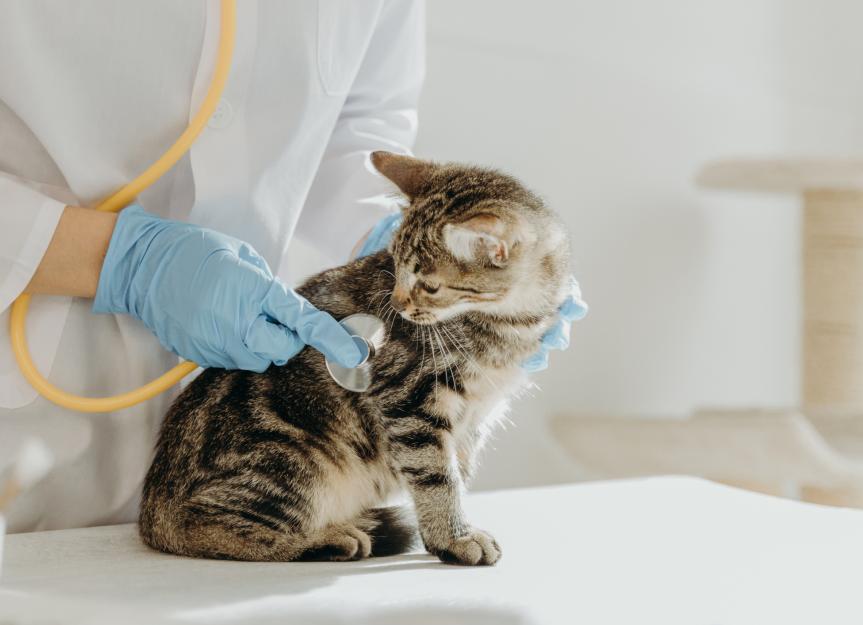
Did you just get a new kitten from the shelter, and they started sneezing a week later?
Don’t fret—upper respiratory infections are common in cats, especially those who have recently joined the family from a rescue, shelter, or breeder.
Where there are lots of kitties housed near one another, there are lots of opportunities to see an upper respiratory infection in cats.
Let’s look at everything a pet parent should know, and what to do if you notice symptoms.
Key Takeaways
- Upper respiratory infections in cats are usually caused by viruses like feline herpesvirus or calicivirus and are highly contagious, especially in multi-cat environments.
- Common symptoms include sneezing, nasal discharge, eye drainage, congestion, and decreased appetite; more severe cases may require veterinary attention.
- Treatment depends on severity and may include supportive care, antibiotics, eye drops, and immune-boosting supplements; most cats recover in one to two weeks.
- Preventive steps include routine FVRCP vaccination, reducing exposure to other cats, and isolating new or symptomatic pets to prevent spread.
What Is an Upper Respiratory Infection in Cats?
Upper respiratory infections in cats are the result of either a viral or bacterial infection.
They are usually contagious and readily spread from cat to cat, leading to sneezing and drainage from the eyes and nose.
While some affected cats can act and feel completely normal besides some sneezing, other affected cats can feel very sick and stop eating. The severity of signs depends on what virus or bacteria they have and how strong their immune system was before the infection.
Respiratory infections enter the cat’s body from their airways. They breathe in contagious particles, which land in their respiratory tract and lead to illness.
If your cat is still bright, has decent energy, and is eating, they can wait and be seen by a veterinarian during normal business hours. If they are depressed and stop eating, an emergency visit may be needed.
Symptoms of an Upper Respiratory Infection in Cats
Symptoms of an upper respiratory infection in cats may include the following:
Causes of an Upper Respiratory Infection in Cats
Upper respiratory infections in cats can be the result of a viral infection, bacterial infection, or both. Over 90% of upper respiratory infections in cats are caused by either feline herpesvirus-1 or feline calicivirus.
Feline herpesvirus, also known as feline viral rhinotracheitis (FVR), is the most common cause of upper respiratory infections in cats.
Researchers estimate that 97% of the cat population will be exposed at some point in their lifetimes. It usually leads to sneezing and nasal drainage for a couple of weeks before the symptoms go away.
While signs of the virus clear up, the virus itself stays in the cat’s system and can flare up again in the future during times of stress.
Calicivirus is the second most common upper respiratory infection in cats. It often leads to cold-like symptoms.
Affected kitties will often sneeze, have drainage from their nose and eyes, and often develop ulcers in their mouths, leading to drooling in some cats. A mild lameness and fever may also happen.
Other viruses and bacteria can cause upper respiratory infections in cats as well.
Chlamydophila felis, Mycoplasma felis, and Bordetella bronchiseptica are the most common bacterial culprits. All of these are readily spread from cat to cat through their saliva, nose or eye drainage, and droplets in the air when they sneeze.
Young cats are more commonly affected by upper respiratory disease, especially those in shelters, rescues, and breeding colonies where lots of cats are housed near one another.
How Veterinarians Diagnose an Upper Respiratory Infection in Cats
Upper respiratory infections in cats are usually diagnosed following a physical exam by your vet.
They will look in your cat’s eyes and ears and at their nostrils for signs of inflammation (swelling) and drainage. They will feel your cat’s lymph nodes for any swelling and listen to their lungs. They will also take the pet’s temperature.
The following tests may also be recommended:
-
Feline leukemia and FIV (feline immunodeficiency virus) testing. These are common viruses that can lower a cat’s immune system, making them more at risk of upper respiratory infections.
-
Bacterial culture or PCR test. Sometimes swabs of the nose, eyes, or mouth are recommended. These swabs can be sent off for a bacterial culture or a polymerase chain reaction (PCR) test to look for viral DNA.
Upper respiratory infections are common. They often clear up on their own and are readily diagnosed with an exam.
However, let your vet know if your cat is not eating well or is acting depressed. This may change their diagnostic or treatment recommendations.
Treatment of an Upper Respiratory Infection in Cats
If your cat’s upper respiratory infection is mild, they may not need any treatment. Often, common viral infections, like feline herpesvirus, will clear up on their own after a couple weeks.
Sometimes eye medications, like tobramycin drops or Terramycin ointment, are prescribed if your cat has goopy eyes.
Antibiotics, like Clavamox or azithromycin, may also be prescribed if a bacterial infection is suspected.
If your cat has a fever or is in pain, an anti-inflammatory medication such as Onsior may be prescribed.
Herpesvirus is not cured, but it does go into remission.
Most cats with upper respiratory infections are treated uneventfully.
Some cats may have a herpes flare-up when they’re young and never have another upper respiratory infection for the rest of their lives.
Others may have their symptoms return when they get stressed, like when their pet parents move to a new home or get a dog. During stressful times like these, ask your vet if a calming chew, like VetriScience Veterinary Strength Calm & Confident Composure Soft Chew Calming Supplement for Cats, is OK to offer your pet.
Recovery and Management of an Upper Respiratory Infection in Cats
Recovery from an upper respiratory infection in cats usually takes one to two weeks.
During that time, it’s helpful to keep your cat’s airways moistened. Keep them in the bathroom while you shower so they can breathe in the steamy air for a few minutes.
You can also use infant saline nose drops to moisten the airways, if your cat allows.
As their sense of smell may be decreased from a stuffy nose, consider offering them more tasteful, fragrant canned food (such as Fancy Feast Gravy Lovers) or using toppers (such as Rachel Ray Nutrish Purrfect Broths) to encourage them to eat.
Prevention of an Upper Respiratory Infection in Cats
Your cat’s risk of getting an upper respiratory infection can be reduced with vaccinations.
While vaccination doesn’t always prevent the viruses it targets, it does lessen the severity of their symptoms if they are exposed.
The FVRCP vaccine that is recommended for healthy kittens and most adult cats is protective against many of the most common viruses that cause upper respiratory infections in cats.
FVRCP stands for:
Aside from vaccinating your cat, you can also reduce their risk by minimizing their exposure to other cats.
If you visit cat cafes or other places where there are cats outside your home, be sure to wash your hands before returning to your house.
If you have a cat in your home with an upper respiratory infection, separate them in their own room for three weeks to avoid shared food and water bowls or mutual grooming.
Wash your hands thoroughly between handling infected and unaffected cats.
To be on the safe side, isolate new cat additions to your home for a couple of weeks, to ensure they don’t start showing signs of upper respiratory infections before being introduced to your other cats.
Upper Respiratory Infection in Cats FAQs
How do I treat my cat’s upper respiratory infection?
While many upper respiratory infections will clear up on their own, some may need medicated eye drops or oral antibiotics.
Can a cat survive an upper respiratory infection?
Most cats will survive getting an upper respiratory infection and have a full recovery.
How long does it take a cat to get rid of an upper respiratory infection?
Most upper respiratory infections clear up after a couple weeks.
Is a cat’s upper respiratory infection contagious to humans?
Cat upper respiratory infections are not generally considered contagious to humans.



